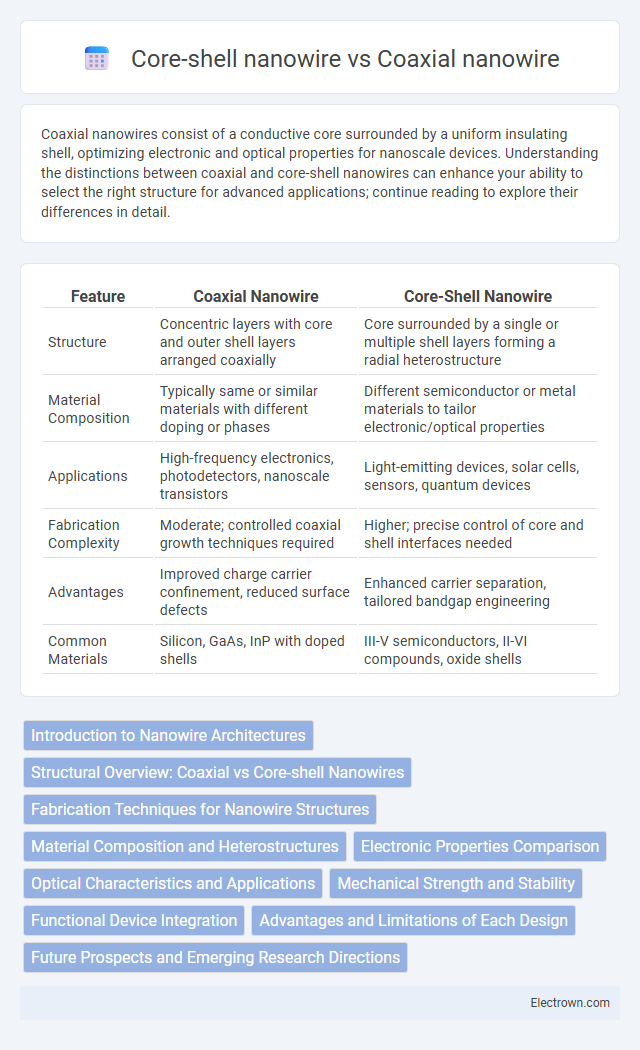Coaxial nanowires consist of a conductive core surrounded by a uniform insulating shell, optimizing electronic and optical properties for nanoscale devices. Understanding the distinctions between coaxial and core-shell nanowires can enhance your ability to select the right structure for advanced applications; continue reading to explore their differences in detail.
Table of Comparison
| Feature | Coaxial Nanowire | Core-Shell Nanowire |
|---|---|---|
| Structure | Concentric layers with core and outer shell layers arranged coaxially | Core surrounded by a single or multiple shell layers forming a radial heterostructure |
| Material Composition | Typically same or similar materials with different doping or phases | Different semiconductor or metal materials to tailor electronic/optical properties |
| Applications | High-frequency electronics, photodetectors, nanoscale transistors | Light-emitting devices, solar cells, sensors, quantum devices |
| Fabrication Complexity | Moderate; controlled coaxial growth techniques required | Higher; precise control of core and shell interfaces needed |
| Advantages | Improved charge carrier confinement, reduced surface defects | Enhanced carrier separation, tailored bandgap engineering |
| Common Materials | Silicon, GaAs, InP with doped shells | III-V semiconductors, II-VI compounds, oxide shells |
Introduction to Nanowire Architectures
Coaxial nanowires consist of a conductive core surrounded by one or more concentric shells, optimizing electrical and optical properties through radial heterostructures. Core-shell nanowires feature a distinct core material encapsulated by a shell with different electronic or chemical characteristics, enhancing stability and interface quality. Your choice between these architectures depends on specific applications like photovoltaics, sensors, or nanoelectronics, where control over charge transport and surface passivation is critical.
Structural Overview: Coaxial vs Core-shell Nanowires
Coaxial nanowires consist of multiple concentric cylindrical layers with distinct material compositions arranged radially around a central core, enabling tailored electronic and optical properties through precise interface engineering. Core-shell nanowires feature a single core material encapsulated by a shell layer, optimizing surface passivation and enhancing charge carrier confinement for improved device performance. Structural differences influence their applications in photovoltaics, sensors, and nanoelectronics, where coaxial designs allow complex heterostructures, while core-shell architectures primarily enhance stability and surface-related functionalities.
Fabrication Techniques for Nanowire Structures
Coaxial nanowire fabrication typically involves vapor-liquid-solid (VLS) growth combined with atomic layer deposition (ALD) or chemical vapor deposition (CVD) to precisely control shell thickness and composition. Core-shell nanowires are commonly produced using molecular beam epitaxy (MBE) or metal-organic chemical vapor deposition (MOCVD), enabling epitaxial growth of a shell layer with uniform crystallinity around the core. Both techniques emphasize nanoscale precision in layer control to optimize electronic and optical properties for advanced device applications.
Material Composition and Heterostructures
Coaxial nanowires typically consist of a semiconductor core surrounded by a concentric shell of a different semiconductor material, enabling radial heterostructures that enhance electronic and optical properties through bandgap engineering. Core-shell nanowires can incorporate multiple material layers with distinct compositions, such as III-V or II-VI semiconductors, allowing for tailored strain management and improved carrier confinement. Both structures exploit lattice mismatch and interface quality within heterostructures to optimize performance in nanoscale devices like lasers, photodetectors, and solar cells.
Electronic Properties Comparison
Coaxial nanowires exhibit enhanced electron mobility and reduced interface scattering due to their concentric conductive layers, improving overall electronic transport compared to core-shell nanowires. Core-shell nanowires often present tunable bandgap energies and effective charge separation, but their electronic performance may be limited by interface defects and strain between core and shell materials. Your device's electronic efficiency can be optimized by selecting coaxial nanowires for higher conductivity or core-shell structures for tailored optoelectronic properties.
Optical Characteristics and Applications
Coaxial nanowires exhibit enhanced light absorption and waveguiding due to their concentric layer structure, leading to improved photodetector and solar cell efficiency. Core-shell nanowires provide tunable bandgap engineering and reduced surface recombination, which optimizes their performance in light-emitting diodes and nanoscale lasers. Both nanowire types enable advanced optoelectronic applications by leveraging their unique optical resonance and carrier dynamics.
Mechanical Strength and Stability
Coaxial nanowires exhibit enhanced mechanical strength due to the robust interface between the core and outer shell, which effectively distributes stress and mitigates crack propagation. Core-shell nanowires provide improved stability by combining materials with complementary mechanical properties, offering superior resistance to deformation and environmental degradation. Experimental studies reveal that coaxial structures typically outperform core-shell counterparts in retaining integrity under mechanical strain, making them suitable for flexible electronics and nanomechanical applications.
Functional Device Integration
Coaxial nanowires offer superior electrical conductivity and enhanced surface area, making them ideal for high-performance functional device integration in sensors and optoelectronics. Core-shell nanowires provide tunable electronic and optical properties due to their distinct core and shell materials, which improve charge separation and stability in photovoltaic and light-emitting devices. Your choice between these structures impacts device efficiency and integration complexity, depending on the specific application requirements.
Advantages and Limitations of Each Design
Coaxial nanowires offer superior electron transport efficiency and enhanced surface area for catalytic reactions, benefiting optoelectronic and sensing applications, but they face challenges with complex fabrication processes and structural stability. Core-shell nanowires provide improved material interfaces and strain relaxation, leading to better mechanical flexibility and tunable electronic properties, though they may suffer from reduced carrier mobility due to interface defects and diffusion issues. Both designs require optimization of growth techniques to balance performance gains with scalability and reproducibility in device integration.
Future Prospects and Emerging Research Directions
Coaxial nanowires exhibit enhanced charge carrier separation and improved electrical conductivity, making them promising candidates for next-generation photovoltaic and nanoelectronic devices. Core-shell nanowires with tailored bandgap engineering enable tunable optical properties and superior chemical stability, driving advances in optoelectronics and sensors. Emerging research focuses on integrating hybrid materials and exploring quantum confinement effects to optimize performance for energy harvesting and quantum computing applications.
Coaxial nanowire vs Core-shell nanowire Infographic

 electrown.com
electrown.com